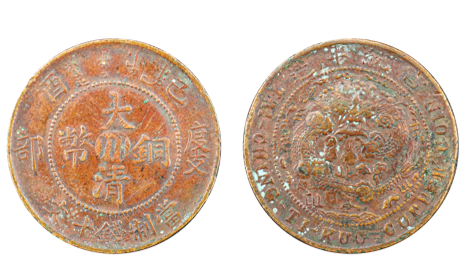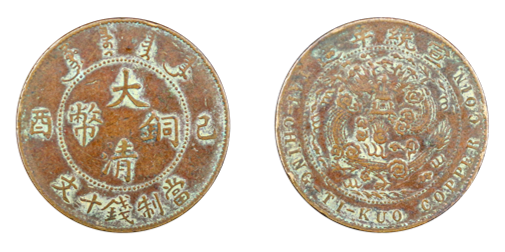|
RECOMMENDED BOUTIQUE -- Xuantong made a pair of Qing copper coins 
*本次藏品 大清铜币当制钱十文一对 典藏尺寸:重量7g 直径29.4mm | 重量7g 直径28.2mm 1905年(光绪三十一年)10月,清政府在天津设立的户部造币总厂开始铸造新式铜元“大清铜币”,并颁布《整顿圜法章程十条》,其中规定:“铜元成色定为用九七紫铜,三厘白铜,原用听锡一厘”;“重量定准当二十者重库平四钱,当十者重库平二钱,当五者重库平一钱,当二者重库平四分”;“统一制造大清铜币,由户部颁发祖模,均与总厂所铸一律,惟于正面加铸省名一字,以便查考。每次铸出,均须呈送财政处户部化验,并由财政处户部随时遵派要员前往稽查”,“各省所铸铜币,应令该省所设官钱公估等局,酌量市面情形定价,随发随收,持之以信”;“各省所铸铜币, 不得大宗贩运出生活上,若各省需用铜币,可备价至总厂领取”。在归并铜元局得以顺利实施的同时,又限定各省每日铸造铜元数额,以避免重蹈滥造的覆辙。此后,清政府将户部改称“度支部”,命各省造币厂改称度支部造币分厂,欲统而治之,巩固中央造币集权。 这一时期铜元的显著特点,正面均钤有汉文“大清铜币”字样,左右边缘分列“户部”和干支纪年文字, 后期去掉“户部”, 仅留干支纪年文字, 上缘列满文“大清铜币”, 下缘列纪值文字; 背面为统一蟠龙, 又称“部颁龙”或“大清龙”, 上缘前期为“光绪年造”、后期为“宣统年造”字样,下缘为英文“TAI—CHING—TI—KUO COPPER COIN”, 汉译为“大清帝国铜币”。户部所铸铜元正面中央无文字,各省所铸铜元正面中央铸一阴文单省名,也有个别为阳文以示区别。币值分为当制钱二十文、十文、五文和二文四种。此阶段新疆地区铸行“宣统元宝”铜元,西藏地区曾铸行“宣统宝藏”铜元,仅此两例。虽然清政府处心积虑改革币制,但未能有效遏制住全国大肆铸造铜元的势头,各省局以利之所在都阳奉阴违,边疆省份云南竟敢违背不准设新厂的诏令, 1907年(光绪三十三年)设局铸行“云”字大清铜币。铜币的使用具有重要的现实意义和历史意义,使交易逐渐便利起来。大清铜币止于1911年(宣统三年),流通时间较短。因其版面设计优雅,雕刻精良,且存世量极为稀少,宣统年造乙酉大清铜币当十被誉为中国近代制币中的十大名誉品之一。 In October 1905 (thirty-one year of Guangxu), the Hubu Coinage General Factory set up by the Qing government in Tianjin began to cast new copper coins "Qing copper coins", and promulgated the "Ten Articles of Association of the Overhaul Law", which stipulated: "Copper yuan is determined to use 97 red copper, three centimeters of white copper, and the original tin one centimetre"; "The weight is fixed when twenty people weigh four cents, when ten people weigh two cents, when five people weigh one dollar, when two people weigh four cents"; "Unified manufacturing of Qing Dynasty copper coins, issued by the Ministry of the ancestral mold, are cast with the head factory, but in the front to add the name of the province, so as to check." Each time, it must be submitted to the Department of Finance for testing, and the Department of Finance at any time to send important officers to inspect ", "the copper coins cast by the provinces should be made by the government of the province to assess the price of the market situation, with the receipt, with the letter"; "The copper coins cast by the provinces shall not be trafficked out of daily life in bulk, and if the provinces need copper coins, they can be prepared to receive them from the general factory." At the same time that the integration of copper yuan Bureau was successfully implemented, the daily amount of copper yuan cast in each province was also limited to avoid repeating the mistake of indiscriminate production. Since then, the Qing government changed the name of the Ministry of Household to "degree branch", and ordered the provinces to change their mints to the degree branch minting branch, in order to unify and govern it, and consolidate the centralization of central coinage. The significant characteristics of copper coins in this period are stamped with the Chinese characters "Daqing copper coins" on the front, and the left and right edges are divided into "Hubu" and Ganzhi chronograms. In the later period, the "Hubu" is removed, and only the Ganzhi chronograms are left, and the Manchu "Daqing copper coins" is listed on the upper edge, and the Ji value characters are listed on the lower edge. On the back is the unified flat dragon, also known as "Ministry dragon" or "Qing dragon", the upper edge is "Guangxu year made" in the early period and "Xuantong Year made" in the later period, and the lower edge is the English "Tai-ching-Ti-Kuo COPPER COIN", which is translated as "Qing Empire copper coin" in Chinese. The front center of the copper yuan cast by the ministry of household has no text, and the front center of the copper yuan cast by the provinces has a single province name in Yin script, and there are also individual Yang scripts to show the difference. The currency value is divided into four types: twenty, ten, five and two. At this stage, the "Xuantong Yuanbao" copper dollar was cast in Xinjiang, and the "Xuantong treasure" copper dollar was cast in Tibet, and there are only two examples. Although the Qing government made every effort to reform the currency system, it failed to effectively curb the momentum of vigorously minting copper coins throughout the country, and the provincial bureaus were all in favor of their advantages. Yunnan, a frontier province, dared to violate the edict not to set up new factories, and in 1907 (the 33th year of Guangxu) set up an bureau to cast "cloud", a Qing copper coin. The use of copper coins has important practical and historical significance, which makes the transaction gradually convenient. Copper coins in the Qing Dynasty ended in 1911 (three years of Xuantong), and the circulation time was relatively short. Because of its elegant layout design, excellent engraving, and extremely rare existence, Xuantong made Yiyou Daqing copper coin Dang ten is known as one of the ten honorary products in modern Chinese coin. 
*本次藏品 己酉度支部大清铜币"川"字当制钱十文 典藏尺寸:重量7g 直径29.4mm 己酉度支部大清铜币"川"字当制钱十文,学名清代机制铜圆,典藏克重7g 直径29.4mm,该钱币表面的包浆自然,正面的字迹和背面的龙纹及英文字清晰可见。钱币正面珠圈内钤有“大清铜币”四字,币心凸起处能看出有一“川”字,乃是四川省的简称;珠圈外上环满文“大清帝国”,满文左右有干支纪年“乙酉”字样,左右分列“度支部”三字,注明由此币的发行部门;相比于“户部”之称,“度支部”存在时间十分短,而宣统帝在位时间更是只有三年,可想而知,此枚度支部大清铜币的稀少程度,收藏价值相对其他版别的大清铜币更是重大。下环可看出其币值“当制钱十文”字样。钱币背面中央为部颁大清龙图案,龙形威猛,鳞甲清晰。上环覆满氧化层,但仍能看出上环“宣统年造”字样,四周环绕英文"Tai-Ching Ti-Kuo Copper Coin"(大清帝国铜币)字样。表现出了当时的国际政治、经济、文化的交融,极具历史意义。 The Qing Dynasty copper coin "Chuan" character is made of ten coins, the scientific name is Qing Dynasty mechanism copper circle, the collection gram weighs 7g and has a diameter of 29.4mm. The surface of the coin is natural, and the writing on the front and the dragon pattern on the back and the English word are clearly visible. On the front of the coin, there are four characters of "Daqing copper coin" inscribed inside the bead ring, and the word "Chuan" can be seen at the center of the coin, which is the abbreviation of Sichuan Province; The Manchu "Qing Empire" on the outside of the bead circle, the Manchu has the words "Yiyou" about the Ganzhi period, and the three words "degree branch" are separated around and around, indicating the issuing department of this coin; Compared with the "Ministry of Household", the "degree branch" has a very short existence time, and the reign time of Emperor Xuantong is only three years. It can be imagined that the rarity of this degree branch Qing copper coin and the collection value is more significant than other versions of Qing copper coins. The lower ring can be seen that its value is "when making money ten words". The center on the back of the coin is the ministry of the Qing Dynasty dragon pattern, the dragon shape is fierce, and the scales and armor are clear. The upper ring is covered with oxide layer, but the words "Xuantong made in the year" can still be seen in the upper ring, surrounded by the English words "Tai-Ching Ti-Kuo Copper Coin"(Qing Imperial copper coin). It shows the integration of international politics, economy and culture at that time, which is of great historical significance. 
*本次藏品 大清铜币 典藏尺寸:重量7g 直径28.2mm 己酉大清铜币当制钱十文,学名清代机制铜圆,典藏克重7g 直径28.2mm,这枚己酉大清铜币当制钱十文,与上文己酉度支部大清铜币"川"字当制钱十文为同一干支纪年造。钱币正面珠圈内铸“大清铜币”四字,珠圈外上环满文“大清帝国”,珠圈外下缘镌币值“当制钱十文”,左右铸有干支纪年“己酉”。下环刻有“当制钱十文”字样,清晰地标明了其价值。背面中央则是一蟠龙图案,龙身蜿蜒,鳞甲清晰,腾云驾雾,栩栩如生,展现出古代工匠精湛的雕刻技艺。铜币整体氧化层较明显,包浆自然,透露出岁月留下的痕迹,每一处细节都透露着那个时代特有的韵味与工艺水平,是集收藏与投资于一身的难能可贵的精品。宣统年造己酉大清铜币,诞生于清朝末年,正值社会动荡、经济变革之际。清政府为缓解财政压力,大量铸造铜币以替代制钱流通,本次两枚铜币便是这一时期的产物。它不仅见证了清末货币制度的变迁,也反映了当时社会对稳定货币流通的迫切需求。因其铸造精良、存世量相对较少,加之历史意义深远,己酉大清铜币当制钱十文及其特殊版别在收藏界一直备受瞩目。随着时间的推移,其收藏价值与投资潜力日益凸显,成为众多藏家竞相追逐的稀世珍品。 The Qing Dynasty copper coin is made of ten pieces of money, the scientific name of the Qing Dynasty mechanism copper circle, the collection gram weight is 7g and the diameter is 28.2mm. This Hexi Qing copper coin is made of ten pieces of money, and the above Hexi Qing copper coin "Chuan" word is made of ten pieces of money for the same branch. On the front of the coin, the four words "Qing Dynasty copper coins" are cast in the bead circle, the Manchu "Qing Empire" is on the outside of the bead circle, and the lower edge of the bead circle is engraved with the currency value "when making money ten wen", and the Ganzhi Ji "Ji you" is cast around. The lower ring is engraved with the words "when making money ten articles", which clearly marks its value. The back center is a dragon design, the dragon body winding, clear scales and armor, flying clouds and fog, lifelike, showing the exquisite carving skills of ancient craftsmen. The overall oxidation layer of copper coins is more obvious, and the coating is natural, revealing the traces left by the years. Every detail reveals the unique charm and craft level of that era, and it is a valuable boutique that integrates collection and investment. The Xuantong Dynasty made copper coins, which was born in the late Qing Dynasty, at a time of social unrest and economic change. In order to relieve the financial pressure, the Qing government minted a large number of copper coins to replace the circulation of money, and the two copper coins are the products of this period. It not only witnessed the changes of the monetary system in the late Qing Dynasty, but also reflected the urgent need of the society for stable currency circulation at that time. Because of its fine casting, relatively small amount of existence and far-reaching historical significance, the ten pieces of copper coins and their special editions have been attracting much attention in the collection circle. With the passage of time, its collection value and investment potential have become increasingly prominent, and it has become a rare treasure that many collectors compete to chase. 以上藏品相关信息请与:四川君再来拍卖集团有限公司联系。 For information about the above collections, please contact: Sichuan Jun Zailai Auction Group Co.
|


 主页 > 新闻 >
主页 > 新闻 > 


